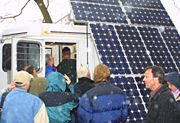
It’s a real treat to be in the focused company of like-minded peers. And if you have a passion for homebuilding, building conferences are where that happens. Attendance requires a commitment of time and money, but if you want to learn, conferences are the place to do it. Other than Breaktime, where else can you hang out with a few hundred experienced, highly motivated professionals who are there to share what they know? This spring, I attended the National Association of Home Builders’ (NAHB’s) Green Builder’s Show in Seattle, while at the same time FHB Assistant Editor David Ericson attended the Northeast Sustainable Energy Association’s (NESEA’s) annual Building Energy conference in Somerville, Mass.
From framing to wind power to house design
The NESEA conference brings together residential and commercial builders but also manufacturers, engineers, utility companies and others interested in a healthy built environment. The conference covered Residential Construction, Commercial Buildings, Green Schools, Clean Energy Technologies, and Public Policy. In four days, Ericson attended a half-day workshop on Photovoltaics and a full day on Planning Issues for the Owner-Builder, as well as regular conference sessions on Energy-Efficient Framing and Air Sealing Details, Building-Integrated Photovoltaics, Wind Power Systems, Manufactured Housing, Heating Systems, Indoor Air Quality, and Small House Design.
NESEA also arranged a preview screening of an HBO documentary called Blue Vinyl, which has won awards at three film festivals so far this year. The film begins with the filmmaker’s parents’ decision to re-side their house with powder-blue vinyl. Blue Vinyl manages to be funny as it explores the balance between vinyl siding’s environmental impact and its popularity as an affordable, low-maintenance building product.
Environmental and corporate responsibility go hand in hand
Back in Seattle, this notion of balancing the economy and the environment might have been the theme of the NAHB show were it not for the opening remarks of Ray Anderson, CEO of Interface, Inc., a multibillion dollar commercial carpet manufacturing corporation that aims to create an environmentally sustainable industry. Under Anderson’s direction, Interface (www.interfaceinc.com) has proven that environmental and corporate responsibility do go hand in hand. Anderson argues that, rather than attempting to balance economic and environmental concerns, we need to recognize that the economy is a subset of the environment, and that, without a healthy world to live in, there would be no economy. As I walked away from his talk (which drew a standing ovation), I could see that the real theme of this show was going to be “doing well by doing good.”
While NESEA drew about 200 participants, NAHB drew over 600. Participants at both conferences presented a number of specific building techniques and new technologies. But one of the underlying principles in green building is the effective conservation and use of resources, or making the smallest change that will achieve the greatest effect, a philosophy that any builder can appreciate. Many participants noted that environmental responsibility isn’t just the right thing to do, it’s also good business.
Green Building and public policy
If you’re wondering what this means to you, the good news is that the folks who have been working for over 20 years to establish Green Building in the industry are eager to share their knowledge. Consequently, the market is growing fast. In 1991, Austin, Texas, had the only formal program in the country, and few people in the industry even understood what “green” meant. One decade later, Denver, Boulder, Seattle, Scottsdale, Tucson, Atlanta, Prince George’s County (Maryland), most of California, and dozens of other communities nationwide have embraced sustainable development as a matter of public policy. Anyone contemplating green building as a way to stand out from the crowd had better hurry up.
Part of the appeal of Green Building is that you can start anywhere and get positive results. If energy efficiency appeals to you, start there. Likewise for building envelope design, indoor air quality, waste reduction, and siting strategies. Of course Green Building is more than business and engineering. At both conferences, builders, code officials and architects alike agreed that Green Building involved working above the standard — striving not just for sustainability but for a greater degree of excellence in the built environment. As visionary architect William McDonough pointed out recently, striving just for “sustainability,” is aiming too low. McDonough asks how we might feel if we were to ask someone “How’s your marriage” and they replied “Oh, it’s sustainable.”
Web resources for information on Green Building
Environmental Building News: www.buildinggreen.com
Northeast Sustainable Energy Association: www.nesea.org
U. S. Green Building Council: www.usgbc.org
Iris Communications: www.oikos.com
NAHB’s 2003 Green Building Conference, click “Green Building” at www.nahbrc.org
Dave Crosby is a custom home builder in Santa Fe, New Mexico. Photo: David Ericson
Fine Homebuilding Recommended Products
Fine Homebuilding receives a commission for items purchased through links on this site, including Amazon Associates and other affiliate advertising programs.

Handy Heat Gun

Affordable IR Camera

8067 All-Weather Flashing Tape






















